This is the ninth installment in our series breaking down the major trades of the 2022 offseason. As opposed to giving out grades, this series will explore why the teams were motivated to make the moves. Let’s dive into the biggest deal of the summer so far, a transaction that saw a four-time All-NBA center head from the Jazz to the Timberwolves…
Minnesota has had an NBA team since 1989. In 33 seasons, the Timberwolves have had a winning record nine times and made the postseason 10 times.
They have advanced past the first round of the playoffs once in their 33-year history – in 2003/04, when MVP Kevin Garnett led the Wolves to the Western Conference Finals, where they ultimately fell to the Lakers in six games. Garnett was the driving force behind eight of the team’s 10 postseason trips.
The Wolves have made the playoffs twice in the past 18 years. For the majority of their existence, they unfortunately have been a laughingstock around the league.
In ‘21/22, Minnesota doubled its win total (23 to 46) and reached the playoffs. Despite a frustrating first-round loss to Memphis, a series in which the Wolves blew multiple big fourth quarter leads – and one which they probably should have won – the season was still an all-around success and certainly a positive step forward.
Minnesota is not a free agent destination, so the only realistic way to acquire a top-tier talent is through the draft or via trade. It’s a smaller market, and the Wolves have been poorly run from top to bottom for decades.
Gobert, meanwhile, has been the single most impactful defensive player in the NBA over the past six regular seasons, and it’s not particularly close. He has been named to six consecutive All-Defensive First Teams and has won Defensive Player of the Year three times since ’16/17, finishing no worse than third in voting in the years he hasn’t won.
When Gobert was the nearest defender to an opponent last season, that opponent shot 6.9% worse than his expected field goal percentage, the second-best mark in the league among all players who received regular minutes. Of players who defended at least five shots per game at the rim, Gobert held the stingiest defensive field goal percentage, limiting opponents to just 49.3%.
Minnesota struggled with defensive rebounding throughout the ’21/22 season, ranking 25th in the league, and the postseason was no different — the Grizzlies outrebounded the Wolves by an average of 6.3 boards per game over the six-game series, and most of that differential came on the offensive glass (12.5 per game vs. 7.0). Minnesota’s inability to control its own paint was a huge detriment in the series.
In addition to being the league’s foremost rim protector, Gobert also led the league in rebounds per game last season with 14.7, including a league-high 36.3% defensive rebounding percentage.
Advanced stats like net rating, win shares, plus/minus, estimated plus/minus, and RAPTOR paint Gobert as a top-15 regular season player over the past six seasons. He is nearly single-handedly capable of leading a team to a top-10 defense.
The Jazz made the playoffs in each of the past six years with the 7’1” Frenchman as the team’s best player. Considering Minnesota hasn’t had sustained success since Garnett’s first run with the team, trading for an elite floor-raiser in Gobert was obviously an attractive option.
The fact that Gobert had spent his entire career with another small market franchise and was open to playing for the Wolves were also positives for Minnesota. He’s under contract for four more years (the final year being a player option), so he could be a long-term fixture in the lineup.
As new president of basketball operations Tim Connelly explained a few weeks ago, being able to deal for Gobert without giving up a top player in return was a major factor in the team’s decision.
“We gave up a lot. There’s no two ways about it,” Connelly said. “Tremendous draft capital, really good players, really good guys. But when you’re able to add a guy that’s as good as Rudy and not touch your top two or three players, it’s really, really rare.”
When was the last time you could say you were confident that the Timberwolves would be a very good team entering the next season? The West is stacked with talent, but I still believe Minnesota is firmly entrenched as a playoff team entering ‘22/23.
Despite Gobert’s regular season dominance, his arrival doesn’t necessarily guarantee a deep playoff run, and with all the Wolves gave up to acquire the big man, that’s where this deal will ultimately be measured.
It has been suggested that Gobert has been a hindrance defensively in the postseason, particularly during the past few years. That perception was generated partly due to the inflexibility of Utah’s drop coverage, which allows the ball-handler to essentially get a three-pointer for “free” in a pick-and-roll, depending on how the on-ball defender reacts to the screen (the scheme says that Gobert should drop backwards and protect the paint).
The reality is, Gobert was the only thing holding Utah’s defense afloat. Anyone who watched the Mavericks’ guards easily get past the Jazz’s perimeter defenders in their first-round matchup last season can tell you that there is only so much one person can do if nearly everyone around him is a weak link.
Much of the criticism directed at Gobert stemmed from Utah’s second-round loss to the Clippers in 2021, which is ironically when Gobert made the most impact during his playoff career — the Jazz were 15.3 points per 100 possessions better with him on the court during the series, including +11.5 on defense. But people remember the second-half collapse of Game 6, when Terance Mann exploded for 39 points on 15-of-21 shooting, including 7-of-10 from three, and Gobert was the “nearest” defender for many of the baskets.
In 167 games over the past two seasons, including the 2021 playoffs, Mann has scored 20+ points eight times. He has scored between 20 and 25 points in seven of those games, making no more than four three-pointers. The eighth was Game 6.
In the first five games of the series, Mann was averaging 5.0 PPG and was a total of 2-of-9 from deep.
I like Mann and think he is a very solid player, but that Game 6 performance is the definition of a statistical outlier. The Jazz left him open as part of an intentional strategy that obviously came back to bite them due to his clutch shot-making.
It’s true to some extent that a five-out strategy (five shooters on the floor) like the Clippers and Mavericks employed mitigates Gobert’s effectiveness as a rim protector. That’s true of any big man who excels in the paint. That’s not to say Gobert is a weak perimeter defender – he is above-average for a center – it’s just not why he gets paid so much money.
The real reason the five-out strategy has been effective against Gobert isn’t a supposed defensive weakness — it’s due to his limitations on offense.
Gobert cannot reliably score down low against smaller players because he basically has no post game. He has no go-to move. And if you can’t exploit your size advantage, five-out is hard to deal with.
He does some things very well on offense. He is a solid (and often illegal) screener. His rim-running will bring a different dimension to pick-and-rolls with D’Angelo Russell, as Karl-Anthony Towns prefers to pop out for threes rather than roll and catch lobs like Gobert.
Beyond catching lobs and getting offensive rebounds, however, Gobert doesn’t have much else in his bag. If he had a hook shot or a reliable baseline jumper, something to keep opposing defenses honest, it would be a different story, but he doesn’t.
Towns is who he is at this point: an extremely talented and skilled offensive player who is sometimes prone to making poor on-ball decisions. He is one of the best shooting big men of all time, and he can score from all over the court in a variety of ways.
His defensive limitations are well-known by now too. He can move his feet pretty well when he’s motivated, but his rebounding has rather inexplicably gotten a bit worse the past few seasons, and he is foul prone. He is guilty of chasing blocks he has no business going after, leaving the weak side vulnerable.
How Towns and Gobert mesh in the regular season is a non-issue, in my opinion. They have complementary skill sets on both ends of the court. How they fare in the playoffs is another story.
This might sound strange given how much I’ve written about Gobert, but I don’t believe this trade will necessarily be judged by his individual performance. As I said, he is an elite floor-raiser due to his excellent defense, and a limited offensive player.
The Jazz were unable to get past the second round of the postseason with Gobert as their best player – whether that’s on him or not is open to debate, but all six of those groups were flawed for various reasons. He is not a ceiling-raiser because he can’t create shots for himself or for others.
Minnesota’s ceiling will hinge on the development of Anthony Edwards, who has the talent to be an MVP-caliber player in the future. Forward Jaden McDaniels, now entering his third season, is also an underrated piece of Minnesota’s core who could push the team’s ceiling higher.
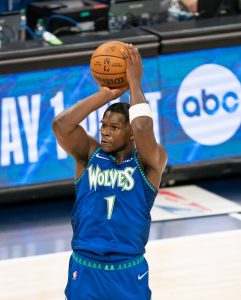 Tony Jones of The Athletic reported that part of the reason why Minnesota gave up so many first-round picks was because it didn’t want to include the versatile McDaniels, who defended Ja Morant as well as anyone I’ve seen during the Memphis series (Morant shot .386/.200/.712 and his scoring was down nearly six points per game vs. the regular season, though he still had a big impact in other areas).
Tony Jones of The Athletic reported that part of the reason why Minnesota gave up so many first-round picks was because it didn’t want to include the versatile McDaniels, who defended Ja Morant as well as anyone I’ve seen during the Memphis series (Morant shot .386/.200/.712 and his scoring was down nearly six points per game vs. the regular season, though he still had a big impact in other areas).
I admire the Wolves for going all-in and betting on Edwards’ boundless potential, because the move was as much about their faith in him as it was about Gobert. It would have been easy to sit back and wait, or go for a smaller move around the edges.
Do I think it was a wise decision to give up so many unprotected first-round picks? Absolutely not. It was a huge and very risky gamble. But the Wolves have been bad for a long time, and Gobert provides a baseline level of competence the team hasn’t had since KG was around.
The ‘22/23 Wolves have arguably the most talented roster in franchise history. It is definitely the most talented and well-rounded group Gobert has ever played with. If you’re a fan of the team, that has to be exciting. Whether or not it manifests in playoff success will only be determined with time.
My biggest question on the Wolves’ end is, who were they bidding against? What other team was willing to give up so much for a great but flawed player with a huge contract?
Were they bidding against the possibility of the Jazz just keeping Gobert? It’s hard to imagine the center having such a robust market due to his limitations, but maybe I’m wrong. That’s another fascinating angle of this deal that will probably only be revealed with time, if it ever becomes public.
The Jazz’s perspective:
Gobert was a developmental success story for the Jazz. The 27th pick of the 2013 draft, he transformed from a raw, skinny prospect into the league’s most formidable rim protector. He is nearly universally beloved in Utah for his off-court work and character as much as his on-court production.
Having said that, the Jazz’s side of this trade is pretty easy to understand. The team had topped out, reportedly viewed Gobert’s contract as a hindrance (he is owed a guaranteed $123MM over the next three seasons, with a $46.7MM player option for ‘25/26), and got an enormous haul of assets for a limited offensive player.
In addition to the players and draft capital they received, the Jazz also gained both short- and long-term financial flexibility by moving off Gobert’s deal. Only Kessler will have fully guaranteed money on his contract beyond ’22/23 (Vanderbilt has a partial guarantee for $300K in ’23/24).
It has been more than three weeks since this trade was agreed to, and I’m still stunned by Utah’s return. Let’s start with the players first, since there’s data to dig into, and then we’ll get to the picks.
Beverley has been a valuable role player for several years. His defense isn’t quite at the level it once was, but he’s still above-average on that end. He brought a competitiveness Minnesota had lacked for several years. The veteran guard has reached the postseason in eight of his 10 seasons, starting for seven of those playoff teams, and that is not a coincidence. He is a winning player.
Beverley is a tenacious rebounder, takes care of the ball, and is a career 37.8% three-point shooter. Despite recently turning 34 years old, he is definitely a positive asset, and at $13MM next season, he is on a reasonable, expiring deal. He’ll return solid value if he’s traded (which seems likely).
Vanderbilt is one of the more unique players in the league because the most important feature of basketball is putting the ball in the hoop, and he’s not very good at it. I called Gobert a limited offensive player, but he has a 7’9″ wingspan and is a lob threat. Vanderbilt is much more limited than Gobert.
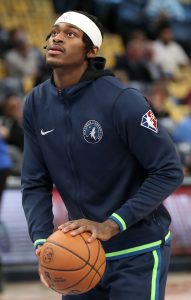 Still, Vanderbilt is a great rebounder (11.9 per 36 minutes), a strong, versatile defender, is very athletic, and plays with tremendous energy. The problem is, he is functionally a center offensively because he has no shooting range – his average shot distance over the last two seasons was 2.8 feet (for context, Gobert’s was 2.7).
Still, Vanderbilt is a great rebounder (11.9 per 36 minutes), a strong, versatile defender, is very athletic, and plays with tremendous energy. The problem is, he is functionally a center offensively because he has no shooting range – his average shot distance over the last two seasons was 2.8 feet (for context, Gobert’s was 2.7).
If Vanderbilt was a little bit bigger, or could do much beyond dunking on offense, he would be an excellent player. As is, he’s a plus bench piece who can start next to an elite frontcourt floor-spacer like Towns.
He is only 23 years old and under contract for two more seasons at a combined $8.96MM, making him an attractive and affordable option (the second year is only partially guaranteed for $300K). He is reportedly drawing plenty of interest from rival clubs.
On the opposite end of the spectrum is Beasley, a poor defender whose value lies almost entirely in his ability to shoot and score. His teams have been better with him off the court than on in each of the past four seasons, which isn’t a great sign. In the Memphis series, for instance, Minnesota was +2.2 per 100 possessions in 169 minutes with Beasley off the court, and -14.1 in 119 minutes with him on it, for an almost impressively bad net rating of -16.3.
However, he averaged nearly 20 points per game two seasons ago and is an athletic, high-volume three-point shooter with a career mark of 38.6%. He’ll make $15.46MM next season on a pseudo-expiring deal ($16.52MM team option in ‘23/24).
I could see a team gambling on Beasley having a bounce-back season because outside shooting is always coveted, but I’d be surprised if the Jazz get a great return for him.
After being selected with the 23rd overall pick of the 2020 draft, Bolmaro spent one more season overseas with Spanish club FC Barcelona, then signed his rookie contract in 2021. However, he rarely saw action last season for the Wolves, appearing in 35 games with an average of just 6.9 minutes per contest.
I’ve never actually seen Bolmaro play, but according to Andy Larsen of The Salt Lake Tribune, he’s a 6’6” play-making wing with solid defense, and his NBA success might hinge upon his ability to make shots. Assuming he sticks with the Jazz and they enter a full-fledged rebuild, which isn’t a given, he could get an extended run next season.
Kessler was the 22nd pick out of Auburn after leading the country in total blocked shots and averaging 4.6 per game. How translatable his game is to the next level remains to be seen.
In addition to the handful of players they received for Gobert, the Jazz acquired unprotected first-round picks in 2023, 2025, 2027, a top-five protected pick in 2029, and a pick swap in 2026. Even writing that out is shocking.
I fully expect the 2023 pick to land in the 20s, barring major injuries. And even though Gobert will be 33 during the ’24/25 season, I still expect the Wolves to be good then. Towns will be 29, Edwards 23, and McDaniels 24.
The pick swap in 2026 is when things start getting really dicey, because the salary cap is expected to go up exponentially in 2025, and if Gobert is playing at anywhere close to the level he has the past six years, he could turn down that player option (even though it’s enormous) and look for a longer deal. Will the Wolves want to pay a player who is likely to be on the decline at that point?
The picks in 2027 and 2029 are obviously big risks as well. As talented as Edwards is, and he certainly looks the part of a future star, a major injury could change that trajectory – I sincerely hope not, but it’s always a risk.
No one thought the Clippers and Lakers would be lottery teams in 2022 after they traded for Paul George and Anthony Davis just three years ago. Injuries are always a factor in sports, and a major reason why dealing away unprotected picks is so risky.
In total, that’s three unprotected picks, a lightly protected pick seven years from now, a pick swap, two starters on a playoff team, a rotation regular who can shoot, and two players on rookie deals in exchange for an offensively limited center whose defensive excellence was the benchmark of the Jazz’s success for the better part of a decade.
If you’re the Jazz, there’s no way you can say no to that trade. No chance. Gobert admitted as such when he was asked why Utah would trade him at his introductory press conference for the Wolves, and gave a thoughtful reply in the process.
It’s easy to look like you’ve won a trade when you receive draft picks in return. Maybe those picks turn into a three-time Defensive Player of the Year. Maybe not. Gobert will be missed by Utah next season, there’s no doubt about that.
Utah could flip those picks for win-now pieces, but I don’t think that’s likely after selling off Royce O’Neale to the Nets as well. The Jazz are tied for the second-most regular season wins in the NBA over the past four years, and are third in the league in regular season wins over the past six years. We’ll see how long it takes them to get back to that same level.
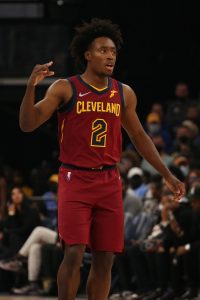
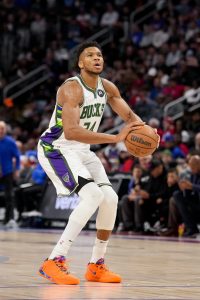
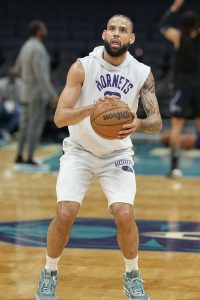
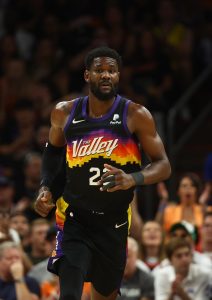
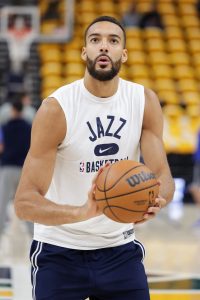 It’s hard to overstate just how dominant he has been. The counting stats are very good – he has averaged 14.8 PPG, 13.1 RPG and 2.3 BPG in 423 games (32.6 MPG) over that same time period, shooting 67.3% from the field and 65.1% from the free throw line – but they don’t adequately reflect his impact.
It’s hard to overstate just how dominant he has been. The counting stats are very good – he has averaged 14.8 PPG, 13.1 RPG and 2.3 BPG in 423 games (32.6 MPG) over that same time period, shooting 67.3% from the field and 65.1% from the free throw line – but they don’t adequately reflect his impact. Tony Jones of The Athletic
Tony Jones of The Athletic Still, Vanderbilt is a great rebounder (11.9 per 36 minutes), a strong, versatile defender, is very athletic, and plays with tremendous energy. The problem is, he is functionally a center offensively because he has no shooting range – his average shot distance over the last two seasons was 2.8 feet (for context, Gobert’s was 2.7).
Still, Vanderbilt is a great rebounder (11.9 per 36 minutes), a strong, versatile defender, is very athletic, and plays with tremendous energy. The problem is, he is functionally a center offensively because he has no shooting range – his average shot distance over the last two seasons was 2.8 feet (for context, Gobert’s was 2.7).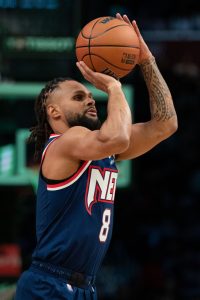
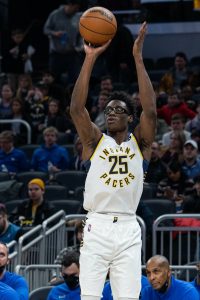
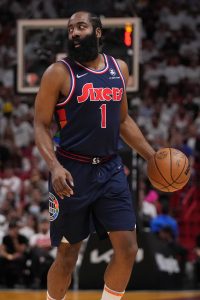
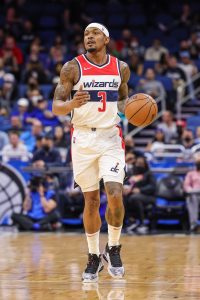 No-trade clauses are rare in the NBA, and had become even rarer in recent years. Beal is just the 10th player in NBA history to receive one.
No-trade clauses are rare in the NBA, and had become even rarer in recent years. Beal is just the 10th player in NBA history to receive one.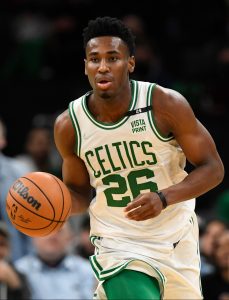 I’m skeptical that Theis will play much for Indiana after having a poor season in the first year of his new contract, especially considering he’s 30 years old himself. He might be a veteran presence for a young team, but the majority of the frontcourt minutes will go to
I’m skeptical that Theis will play much for Indiana after having a poor season in the first year of his new contract, especially considering he’s 30 years old himself. He might be a veteran presence for a young team, but the majority of the frontcourt minutes will go to 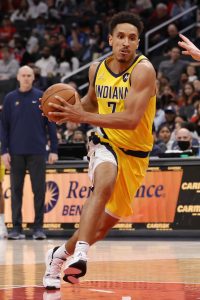 Brogdon uses that strength on offense to his advantage as well, bullying smaller players in drives to the basket. He isn’t the quickest or most athletic player, but he can get to his spots for the most part and does a solid job of drawing contract.
Brogdon uses that strength on offense to his advantage as well, bullying smaller players in drives to the basket. He isn’t the quickest or most athletic player, but he can get to his spots for the most part and does a solid job of drawing contract.